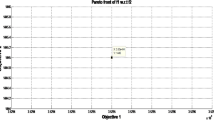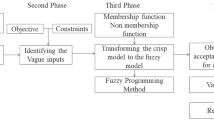Abstract
In this paper, we have assumed an inventory multi-objective optimization model under intuitionistic fuzziness. In modelling, we have considered the situations where triangular intuitionistic fuzzy numbers used to express some of the input information which associated with decision variables. Further, a ranking function approach by considering linear and the nonlinear degree of membership functions have been used to obtain the crisp form of the fuzzy parameters. Finally, the fuzzy goal programming approach has been used to solve the resultant model to obtain the optimal ordering quantity. Also, a comparative study of the formulated problem under intuitionistic fuzziness has been done with a deterministic model of inventory. The concept of the paper is explained through a numerical example.






Similar content being viewed by others
References
Atanassov KT (1986) Intuitionistic fuzzy sets. Fuzzy Sets Syst 20(1):87–96
Atanassov KT (1989) More on intuitionistic fuzzy sets. Fuzzy Sets Syst 33(1):37–45
Banerjee S, Roy TK (2010) Solution of single and multiobjective stochastic inventory models with fuzzy cost components by intuitionistic fuzzy optimization technique. Adv Oper Res. https://doi.org/10.1155/2010/765278
Bera UK, Maiti MK, Maiti M (2012) Inventory model with fuzzy lead-time and dynamic demand over finite time horizon using a multi-objective genetic algorithm. Comput Math Appl 64(6):1822–1838
Bhaya S, Pal M, Nayak PK (2014) Intuitionistic fuzzy optimization technique in EOQ model with two types of imperfect quality items. Adv Model Optim 16(1):33–50
Chakraborty D, Jana DK, Roy TK (2014) A new approach to solve intuitionistic fuzzy optimization problem using possibility, necessity, and credibility measures. Int J Eng Math. https://doi.org/10.1155/2014/593185
Chakrabortty S, Pal M, Nayak PK (2013) Intuitionistic fuzzy optimization technique for Pareto optimal solution of manufacturing inventory models with shortages. Eur J Oper Res 228(2):381–387
Chen YF (2005) Fractional programming approach to two stochastic inventory problems. Eur J Oper Res 160(1):63–71
Das B, Maiti M (2012) A volume flexible fuzzy production inventory model under interactive and simulation approach. Int J Math Oper Res 4(4):422–438
De SK, Sana SS (2014) A multi-periods production-inventory model with capacity constraints for multi-manufacturers—a global optimality in intuitionistic fuzzy environment. Appl Math Comput 242(1):825–841
De SK, Goswami A, Sana SS (2014) An interpolating by pass to Pareto optimality in intuitionistic fuzzy technique for a EOQ model with time sensitive backlogging. Appl Math Comput 230(1):664–674
Du W, Leung SYS, Kwong CK (2015) A multi objective optimization-based neural network model for short-term replenishment forecasting in fashion industry. Neuro-computing 151(1):342–353
Dutta D, Kumar P (2013) Application of fuzzy goal programming approach to multi-objective linear fractional inventory model. Int J Syst Sci 46(12):2269–2278
Fattahi P, Hajipour V, Nobari A (2015) A bi-objective continuous review inventory control model: Pareto-based meta-heuristic algorithms. Appl Soft Comput 32:211–223
Fung RYK, Tang J, Wang D (2003) Multiproduct aggregate production planning with fuzzy demands and fuzzy capacities. IEEE Trans Syst Man Cybern Part A Syst Hum 33(3):302–313
Garai A, Ghosh P, Roy TK (2015) Solution of inventory model by Geometric programming technique under intuitionistic fuzzy environment. Optimization 2(6):73–87
Garai T, Chakraborty D, Roy TK (2018) A fuzzy rough multi-objective multi-item inventory model with both stock-dependent demand and holding cost rate. Granul Comput. https://doi.org/10.1007/s41066-018-0085-6
Garg H (2014) Solving structural engineering design optimization problems using an artificial bee colony algorithm. J Ind Manag Optim 10(3):777–794
Garg H (2015a) Fuzzy inventory models for deteriorating items under different types of lead-time distributions. In: Kahraman C, Onar SÇ (eds) Intelligent techniques in engineering management. Springer, Cham, pp 247–274
Garg H (2015b) A hybrid GA-GSA algorithm for optimizing the performance of an industrial system by utilizing uncertain data. In: Vasant P (ed) Handbook of research on artificial intelligence techniques and algorithms. IGI Global, Hershey, pp 620–654
Garg H (2016a) A hybrid PSO-GA algorithm for constrained optimization problems. Appl Math Comput 274(1):292–305
Garg H (2016b) A new generalized improved score function of interval-valued in tuitionistic fuzzy sets and applications in expert systems. Appl Soft Comput 3(8):988–999
Garg H (2017) Novel intuitionistic fuzzy decision making method based on an improved operation laws and its application. Eng Appl Artif Intell 60(1):164–174
Garg H (2018) Analysis of an industrial system under uncertain environment by using different types of fuzzy numbers. Int J Syst Assur Eng Manag. https://doi.org/10.1007/s13198-018-0699-8
Garg H, Arora R (2017) A nonlinear-programming methodology for multi-attribute decision-making problem with interval-valued intuitionistic fuzzy soft sets information. Appl Intell. https://doi.org/10.1007/s10489-017-1035-8
Garg H, Rani M (2013) An approach for reliability analysis of industrial systems using PSO and IFS technique. ISA Trans 52(6):701–710
Garg H, Rani M, Sharma SP (2013) Reliability analysis of the engineering systems using intuitionistic fuzzy set theory. J Qual Reliab Eng 2013, Article ID 943972,10
Garg H, Rani M, Sharma SP, Vishwakarma Y (2014a) Bi-objective optimization of the reliability–redundancy allocation problem for series-parallel system. J Manuf Syst 33(3):335–347
Garg H, Rani M, Sharma SP, Vishwakarma Y (2014b) Intuitionistic fuzzy optimization technique for solving multi-objective reliability optimization problems in interval environment. Expert Syst Appl 41(1):3157–3167
Hariri AMA, Abou-El-Ata MO (1997) Multi-item production lot-size inventory model with varying order cost under a restriction: a geometric programming approach. Prod Plan Control Manag Oper 8(2):179–182
Harris FW (1913) How many parts to make at once. Oper Res 38(6):947–950
Khanra S, Sana SS, Chaudhuri K (2010) An EOQ model for perishable item with stock and price dependent demand rate. Int J Math Oper Res 2(3):320–335
Kumar P, Dutta D (2015) Multi-objective linear fractional inventory model of multi-products with price-dependant demand rate in fuzzy environment. Int J Math Oper Res 7(5):547–565
Kundu A, Chakrabarti T (2011) A production lot-size model with fuzzy-ramp type demand and fuzzy deterioration rate under permissible delay in payments. Int J Math Oper Res 3(5):524–540
Mahapatra GS, Roy TK (2013) Intuitionistic fuzzy number and its arithmetic operation with application on system failure. J Uncertain Syst 7(2):92–107
Mahata GC, Goswami A (2013) Fuzzy inventory models for items with imperfect quality and shortage back ordering under crisp and fuzzy decision variables. Comput Ind Eng 64(1):190–199
Min J, Zhou YW, Liu GQ, Wang SD (2012) An EPQ model for deteriorating items with inventory-level-dependent demand and permissible delay in payments. Int J Syst Sci 43(6):1039–1053
Mondal M, Maity AK, Maiti MK, Maiti M (2013) A production-repairing inventory model with fuzzy-rough coefficients under inflation and time value of money. Appl Math Model 37(5):3200–3215
Nagoorgani A, Ponnalagu K (2012) A new approach on solving intuitionistic fuzzy linear programming problem. Appl Math Sci 6(70):3467–3474
Pando V, Garcı J, San-José LA, Sicilia J (2012) Maximizing profits in an inventory model with both demand rate and holding cost per unit time dependent on the stock level. Comput Ind Eng 62(2):599–608
Pando V, San-José LA, García-Laguna J, Sicilia J (2013) An economic lot-size model with non-linear holding cost hinging on time and quantity. Int J Prod Econ 145(1):294–303
Pentico DW, Drake MJ (2011) A survey of deterministic models for the EOQ and EPQ with partial backordering. Eur J Oper Res 214(2):179–198
Rafiei M, Mohammadi M, Torabi S (2013) Reliable multi period multi product supply chain design with facility disruption. Decis Sci Lett 2(2):81–94
Rani D, Gulati TR, Garg H (2016) Multi-objective non-linear programming problem in intuitionistic fuzzy environment: optimistic and pessimistic viewpoint. Exp Syst Appl 64:228–238. https://doi.org/10.1016/j.eswa.2016.07.034
Roy TS, Ghosh SK, Chaudhuri K (2013) An economic production quantity model for items with time proportional deterioration under permissible delayin payments. Int J Math Oper Res 5(3):301–316
Sabri EH, Beamon BM (2000) A multi-objective approach to simultaneous strategic and operational planning in supply chain design. Omega 28(1):581–598
Sadjadi SJ, Aryanezhad MB, Sarfaraj A (2005) A fuzzy approach to solve a multi-objective linear fractional inventory model. J Indus Eng Int 1(1):43–47
Shah NH, Soni H (2011) A multi-objective production inventory model with backorder for fuzzy random demand under flexibility and reliability. J Math Model Algorithms 10(4):341–356
Singh S, Garg H (2017) Distance measures between type-2 intuitionistic fuzzy sets and their application to multicriteria decision-making process. Appl Intell 46(4):788–799
Singh SK, Yadav SP (2016) Fuzzy programming approach for solving intuitionistic fuzzy linear fractional programming problem. Int J Fuzzy Syst 18(2):263–269
Srivastav A, Agrawal S (2016) Multi-objective optimization of hybrid backorder inventory model. Expert Syst Appl 51(1):76–84
Taleizadeh AA, Wee HM, Jolai F (2013) Revisiting a fuzzy rough economic order quantity model for deteriorating items considering quantity discount and prepayment. Math Comput Model 57(6):1466–1479
Tersine RJ (1994) Principles of inventory and materials management. Prentice Hall, Englewood Cliffs
Tripathi R (2013) Inventory model with different demand rate and different holding cost. Int J Ind Eng Comput 4(3):437–446
Valliathal M, Uthayakumar R (2010) An EOQ model for rebate value and selling-price-dependent demand rate with shortages. Int J Math Oper Res 3(1):99–123
Wee HM, Lo CC, Hsu PH (2009) A multi-objective joint replenishment inventory model of deteriorated items in a fuzzy environment. Eur J Oper Res 197(2):620–631
Wu J, Liu Y (2013) An approach for multiple attribute group decision making problems with interval-valued intuitionistic trapezoidal fuzzy numbers. Comput Ind Eng 66(2):311–324
Xu J, Zhao L (2008) A class of fuzzy rough expected value multi-objective decision making model and its application to inventory problems. Comput Math Appl 56(8):2107–2119
Xu J, Zhao L (2010) A multi-objective decision-making model with fuzzy rough coefficients and its application to the inventory problem. Inf Sci 180(5):679–696
Yadav D, Pundir S, Kumari R (2010) A fuzzy multi-item production model with reliability and flexibility under limited storage capacity with deterioration via geometric programming. Int J Math Oper Res 3(1):78–98
Yang CT (2014) An inventory model with both stock-dependent demand rate and stock-dependent holding cost rate. Int J Prod Econ 155(1):214–221
Zadeh LA (1965) Fuzzy sets. Inf Control 8(3):338–353
Zimmermann HJ (1978) Fuzzy programming and linear programming with several objective functions. Fuzzy Sets Syst 1(1):45–55
Author information
Authors and Affiliations
Corresponding author
Rights and permissions
About this article
Cite this article
Ali, I., Gupta, S. & Ahmed, A. Multi-objective linear fractional inventory problem under intuitionistic fuzzy environment. Int J Syst Assur Eng Manag 10, 173–189 (2019). https://doi.org/10.1007/s13198-018-0738-5
Received:
Revised:
Published:
Issue Date:
DOI: https://doi.org/10.1007/s13198-018-0738-5




